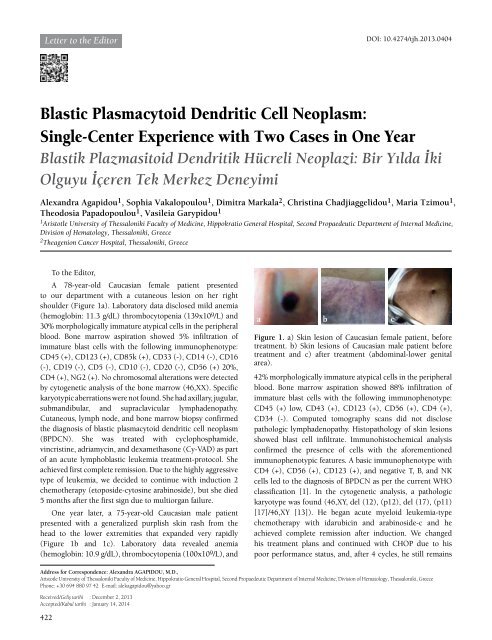Turkish Journal of Hematology Volume: 31 - Issue: 4
Create successful ePaper yourself
Turn your PDF publications into a flip-book with our unique Google optimized e-Paper software.
Letter to the Editor<br />
DOI: 10.4274/tjh.2013.0404<br />
Blastic Plasmacytoid Dendritic Cell Neoplasm:<br />
Single-Center Experience with Two Cases in One Year<br />
Blastik Plazmasitoid Dendritik Hücreli Neoplazi: Bir Yılda İki<br />
Olguyu İçeren Tek Merkez Deneyimi<br />
Alexandra Agapidou 1 , Sophia Vakalopoulou 1 , Dimitra Markala 2 , Christina Chadjiaggelidou 1 , Maria Tzimou 1 ,<br />
Theodosia Papadopoulou 1 , Vasileia Garypidou 1<br />
1 Aristotle University <strong>of</strong> Thessaloniki Faculty <strong>of</strong> Medicine, Hippokratio General Hospital, Second Propaedeutic Department <strong>of</strong> Internal Medicine,<br />
Division <strong>of</strong> <strong>Hematology</strong>, Thessaloniki, Greece<br />
2 Theagenion Cancer Hospital, Thessaloniki, Greece<br />
To the Editor,<br />
A 78-year-old Caucasian female patient presented<br />
to our department with a cutaneous lesion on her right<br />
shoulder (Figure 1a). Laboratory data disclosed mild anemia<br />
(hemoglobin: 11.3 g/dL) thrombocytopenia (139x10 9 /L) and<br />
30% morphologically immature atypical cells in the peripheral<br />
blood. Bone marrow aspiration showed 5% infiltration <strong>of</strong><br />
immature blast cells with the following immunophenotype:<br />
CD45 (+), CD123 (+), CD85k (+), CD33 (-), CD14 (-), CD16<br />
(-), CD19 (-), CD5 (-), CD10 (-), CD20 (-), CD56 (+) 20%,<br />
CD4 (+), NG2 (+). No chromosomal alterations were detected<br />
by cytogenetic analysis <strong>of</strong> the bone marrow (46,XX). Specific<br />
karyotypic aberrations were not found. She had axillary, jugular,<br />
submandibular, and supraclavicular lymphadenopathy.<br />
Cutaneous, lymph node, and bone marrow biopsy confirmed<br />
the diagnosis <strong>of</strong> blastic plasmacytoid dendritic cell neoplasm<br />
(BPDCN). She was treated with cyclophosphamide,<br />
vincristine, adriamycin, and dexamethasone (Cy-VAD) as part<br />
<strong>of</strong> an acute lymphoblastic leukemia treatment-protocol. She<br />
achieved first complete remission. Due to the highly aggressive<br />
type <strong>of</strong> leukemia, we decided to continue with induction 2<br />
chemotherapy (etoposide-cytosine arabinoside), but she died<br />
5 months after the first sign due to multiorgan failure.<br />
One year later, a 75-year-old Caucasian male patient<br />
presented with a generalized purplish skin rash from the<br />
head to the lower extremities that expanded very rapidly<br />
(Figure 1b and 1c). Laboratory data revealed anemia<br />
(hemoglobin: 10.9 g/dL), thrombocytopenia (100x109/L), and<br />
a b c<br />
Figure 1. a) Skin lesion <strong>of</strong> Caucasian female patient, before<br />
treatment. b) Skin lesions <strong>of</strong> Caucasian male patient before<br />
treatment and c) after treatment (abdominal-lower genital<br />
area).<br />
42% morphologically immature atypical cells in the peripheral<br />
blood. Bone marrow aspiration showed 88% infiltration <strong>of</strong><br />
immature blast cells with the following immunophenotype:<br />
CD45 (+) low, CD43 (+), CD123 (+), CD56 (+), CD4 (+),<br />
CD34 (-). Computed tomography scans did not disclose<br />
pathologic lymphadenopathy. Histopathology <strong>of</strong> skin lesions<br />
showed blast cell infiltrate. Immunohistochemical analysis<br />
confirmed the presence <strong>of</strong> cells with the aforementioned<br />
immunophenotypic features. A basic immunophenotype with<br />
CD4 (+), CD56 (+), CD123 (+), and negative T, B, and NK<br />
cells led to the diagnosis <strong>of</strong> BPDCN as per the current WHO<br />
classification [1]. In the cytogenetic analysis, a pathologic<br />
karyotype was found (46,XY, del (12), (p12), del (17), (p11)<br />
[17]/46,XY [13]). He began acute myeloid leukemia-type<br />
chemotherapy with idarubicin and arabinoside-c and he<br />
achieved complete remission after induction. We changed<br />
his treatment plans and continued with CHOP due to his<br />
poor performance status, and, after 4 cycles, he still remains<br />
Address for Correspondence: Alexandra AGAPIDOU, M.D.,<br />
Aristotle University <strong>of</strong> Thessaloniki Faculty <strong>of</strong> Medicine, Hippokratio General Hospital, Second Propaedeutic Department <strong>of</strong> Internal Medicine, Division <strong>of</strong> <strong>Hematology</strong>, Thessaloniki, Greece<br />
Phone: +30 694 880 97 42 E-mail: alekagapidou@yahoo.gr<br />
Received/Geliş tarihi : December 2, 2013<br />
Accepted/Kabul tarihi : January 14, 2014<br />
422

















